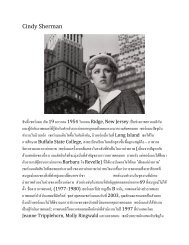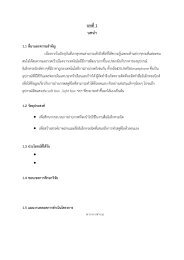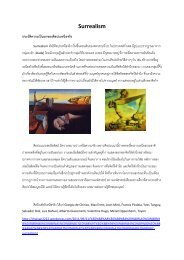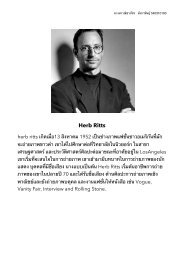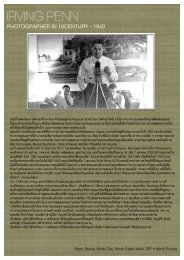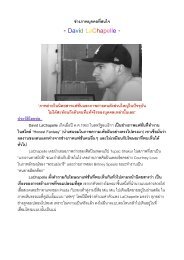Richard Avedon (May 15, 1923 â October 1, 2004) was an American ...
Richard Avedon (May 15, 1923 â October 1, 2004) was an American ...
Richard Avedon (May 15, 1923 â October 1, 2004) was an American ...
Create successful ePaper yourself
Turn your PDF publications into a flip-book with our unique Google optimized e-Paper software.
ecame widely known, he brought in m<strong>an</strong>y famous faces to his studio<strong>an</strong>d photographed them with a large-format 8x10 view camera. Hisportraits are easily distinguished by their minimalist style, where theperson is looking squarely in the camera, posed in front of a sheer whitebackground. Among the m<strong>an</strong>y rock b<strong>an</strong>ds photographed by <strong>Avedon</strong>, in1973 he shot Electric Light Orchestra with all the members exposingtheir bellybuttons for recording, On the Third Day.He is also distinguished by his large prints, sometimes measuring overthree feet in height. His large-format portrait work of drifters, miners,cowboys <strong>an</strong>d others from the western United States became a bestsellingbook <strong>an</strong>d traveling exhibit entitled In the Americ<strong>an</strong> West, <strong>an</strong>d isregarded as <strong>an</strong> import<strong>an</strong>t hallmark in 20th Century portrait photography,<strong>an</strong>d by some as <strong>Avedon</strong>'s magnum opus. Commissioned by the AmonCarter Museum in Fort Worth, Texas, it <strong>was</strong> a six-year project <strong>Avedon</strong>embarked on in 1979, that produced 125 portraits of people in theAmeric<strong>an</strong> west who caught <strong>Avedon</strong>'s eye.<strong>Avedon</strong> <strong>was</strong> drawn to working people such as miners <strong>an</strong>d oil fieldworkers in their soiled work clothes, unemployed drifters, <strong>an</strong>d teenagersgrowing up in the West circa 1979-84. When first published <strong>an</strong>dexhibited, In the Americ<strong>an</strong> West <strong>was</strong> criticized for showing what someconsidered to be a disparaging view of America. <strong>Avedon</strong> <strong>was</strong> also laudedfor treating his subjects with the attention <strong>an</strong>d dignity usually reservedfor the politically powerful <strong>an</strong>d celebrities. Laura Wilson served as<strong>Avedon</strong>'s assist<strong>an</strong>t during the creation of In the Americ<strong>an</strong> West <strong>an</strong>d in2003 published a photo book documenting the experiences, <strong>Avedon</strong> atWork, In the Americ<strong>an</strong> West.<strong>Avedon</strong> became the first staff photographer for The New Yorker in1992. He has won m<strong>an</strong>y awards for his photography, including theInternational Center of Photography Master of Photography Award in1993, the Prix Nadar in 1994 for his photobook Evidence, <strong>an</strong>d the RoyalPhotographic Society <strong>15</strong>0th Anniversary Medal in 2003. In 1944,<strong>Avedon</strong> married Dorcas Nowell, who later became a model <strong>an</strong>d <strong>was</strong>known professionally as Doe <strong>Avedon</strong>. Nowell <strong>an</strong>d <strong>Avedon</strong> divorced afterfive years of marriage.In 1951, he married Evelyn Fr<strong>an</strong>klin; their marriage produced oneson, John. <strong>Avedon</strong> <strong>an</strong>d Fr<strong>an</strong>klin also later divorced.Martial arts movie star Loren <strong>Avedon</strong> is the nephew of <strong>Richard</strong> <strong>Avedon</strong>.On <strong>October</strong> 1, <strong>2004</strong>, he suffered a brain hemorrhage in S<strong>an</strong> Antonio,Texas while shooting <strong>an</strong> assignment for The New Yorker. At the time ofhis death, <strong>Avedon</strong> <strong>was</strong> working on a new project titled On Democracy tofocus on the run-up to the <strong>2004</strong> U.S. presidential election.Hollywood presented a fictional account of his early career in the1957 musical Funny Face, starring Fred Astaire as the fashionphotographer "Dick Avery." <strong>Avedon</strong> supplied some of the stillphotographs used in the production, including its most famous singleimage: <strong>an</strong> intentionally overexposed close-up of Audrey Hepburn's face



